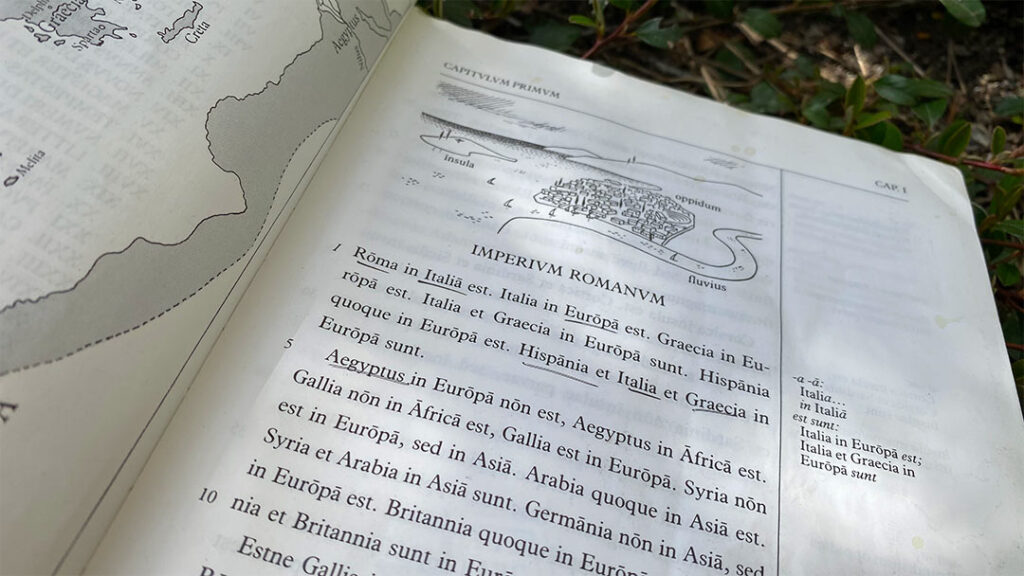Contents
I have been teaching Latin using a combination of spoken Latin and traditional methods for over twelve years, both in private lessons and at university. The textbook I use and always recommend is Familia Romana by Hans Ørberg. The book is written entirely in Latin, and many online ask whether there is an English translation available or not.
Suggested reading: Best books for learning Latin
The Latin textbook Familia Romana does not have an official translation into English or any other language. This is by design. Familia Romana is written entirely in Latin and constructed in such a way as to lead the reader from the easiest Latin such as Roma in Italia est (“Rome is in Italy”) to more complex narrative texts.

How to not need a translation
If you struggle and feel like you need a translation when reading Familia Romana, you are not alone: many students say this. However, this is usually because they are moving too fast through the book. They might say, “I get this, I understand this,” and move on. But it’s very easy to miss the little things that pile up, and before long, the text is “too difficult,” and you need a translation.
To combat this, I have my students work on one chapter diligently: they re-read it carefully at least five times and do all the exercises in the Familia Romana book and the exercise book Exercitia I, at least two times preferably more. In addition, during our sessions, we discuss the text, and I ask questions and create a conversation using the chapter’s vocabulary— in Latin.
To help you get going, you can read this step-by-step method of studying Familia Romana, or if you are pressed for time, below you’ll find a shorter version of the same method:
- Read the first chapter section (Lectio I) looking at the marginal notes and images
- Reread the lectio two more times aloud
- Using pen and paper, do the exercises for that lectio in the Exercise book twice
- Reread the lectio again, trying to picture everything that is happening.
- Repeat the process for the next section.
- When you come to the end of the chapter, read the whole chapter in one go, picturing everything described.
- Do the exercises (Pensum A, B, and C) in the Familia Romana book, which pertain to the whole chapter.
This might seem boring and take much time. That could be true, but what is a guarantee is that with this method, you will master the vocabulary, turns of phrases, and the grammar step-by-step, ever building on it as you progress.
After doing this, you will most likely not require a translation, as you will understand everything perfectly.

What if I still need a translation?
None of my students who diligently follow this method has felt the need to use a translation with Familia Romana. There might be a word or two here or there where you might be unsure: it’s fine to look up that word (after following the method above!) in a Latin dictionary.
Be sure to use a suitable dictionary, such as The Bantam New College Latin & English Dictionary, and not a scholarly dictionary like Lewis & Short or the Oxford Latin Dictionary. These latter two are too detailed and will give you every possible meaning and definition across centuries of authors. At the start, stick with a smaller, more accessible dictionary.
Check out this guide to find the best Latin dictionary for your level.
Why you should avoid using a translation with Familia Romana
Using translations when reading literary works is often a useful tool to clear up any difficulty or get a better sense of the nuances of the Latin words. But, when studying a textbook such as Familia Romana, translations can easily become a crutch, where you always doubt yourself until you check the translation. The translation becomes a sort of soothsaying oracle.
This habit usually follows students for years into their studies, who become dependent on translations and never being comfortable with relying on their own abilities and judgment, always deferring to someone else.
Don’t do that.
Spend more time in the beginning, developing a strong foundation in the language (with the method above) and develop a strong confidence in your own ability to understand and interpret Latin correctly. Later when reading literature, you can then use a translation sparingly when you need to, without feeling the need to constantly consult it.
You will be a confident and better reader if you do.
Good luck!
—Daniel Pettersson
















